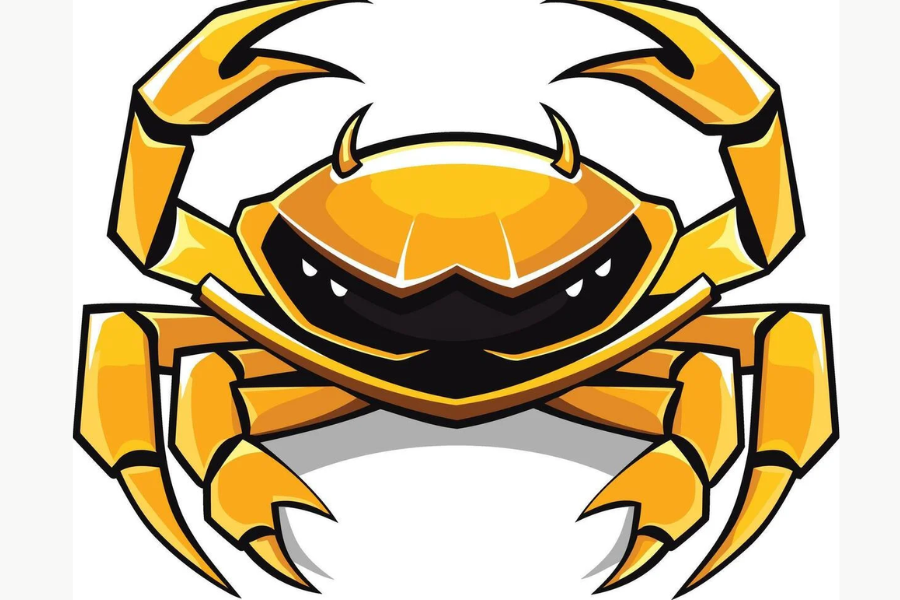When it comes to representing your college, choosing a mascot can be an exciting yet daunting task. A crab mascot might initially seem like an unconventional choice, but its unique qualities can bring an energetic and memorable identity to your school.
Crabs are not only visually interesting but also symbolize resilience, tenacity, and community spirit—perfect attributes for any educational institution. This guide aims to provide an in-depth look at designing a custom crab college logo, ensuring it captures your school’s essence while appealing to students, faculty, and alumni alike.
Why Choose a Crab Mascot?
Crabs might not be the first animal that comes to mind when you think of a school mascot, but their attributes make them a powerful choice. These crustaceans embody resilience and adaptability—qualities that every college strives to instill in its students. Crabs carry their homes on their backs, signifying strength and self-sufficiency. This makes them a fitting metaphor for the challenges students face and the determination they need to succeed.
Moreover, crabs possess a quirky and playful appearance that can be turned into a visually striking and memorable logo. A well-designed crab mascot can embody school pride while engaging the community in fun and creative ways. Whether it’s for sports teams, events, or marketing materials, a crab mascot can stand out and resonate with your college’s culture.
Key Elements of a Mascot Custom Crab College Logo
Creating a mascot logo goes beyond simply selecting a crab image and adding the school’s name. It involves creativity, thoughtfulness, and an understanding of what your institution stands for. Below are the essential elements to consider when designing your custom crab college logo:
1. Character and Personality
The personality of your crab mascot is fundamental to its design. What qualities do you want it to represent? Should it embody fierce competitiveness that instills fear in rival teams, or would a friendly and welcoming crab promote unity and school spirit? Establishing a clear character for your mascot will guide the design process and help communicate your school’s values effectively.
For instance, a crab with a determined expression might resonate well with the athletic teams, while a cheerful crab could be more suitable for community events and student gatherings. Take the time to define your mascot’s persona to ensure that it reflects your college’s culture and mission.
2. Colors That Pop
Color choice is vital when designing a logo. Your crab’s colors should complement and reflect your college’s official colors. While crabs are often portrayed in shades of red and blue, don’t feel restricted by natural colors. Mascot logos provide an opportunity for creativity, so consider using your school colors to enhance brand consistency while ensuring the crab stands out.
Utilizing bright and bold colors can draw attention to your mascot, making it more memorable. Think about color psychology: for example, red can signify passion and energy, while blue can evoke trust and reliability. Choosing the right combination can elevate your mascot’s impact.
3. Unique Features
To set your mascot apart, incorporate unique features that capture your college’s spirit. Consider special poses, accessories, or expressions that can make your crab logo memorable. For instance, a crab wearing a graduation cap could symbolize academic achievement, while one holding sports equipment might reflect school pride in athletics.
These distinctive details can enhance your mascot’s engagement factor, inviting students and alumni to connect more personally with the design. Incorporating elements like a confident smirk or a banner showcasing the school motto can add to the character and charm of your logo.
4. Typography
Typography plays a crucial role in your mascot logo, as it ties together the visual elements and communicates your school’s identity. The font you choose should align with the overall theme of the logo. A bold, blocky font might suggest strength and competitiveness, making it suitable for sports teams, whereas a more elegant script could represent academic excellence.
Ensure that the text is legible at various sizes and complements the mascot’s design. The combination of character, color, and typography will help create a cohesive and impactful logo that resonates with your audience.
5. Versatility
Your crab mascot logo will likely be used in various formats, from small embroidered patches on uniforms to large banners at sporting events. Therefore, it’s essential to ensure your design is versatile. A logo should maintain its clarity and impact whether it’s scaled up for a large display or reduced for business cards.
Designing with versatility in mind will help your logo remain effective across all mediums, allowing it to adapt without losing its identity. Test the design in different sizes and applications to confirm its effectiveness.
The Design Process: Bringing Your Crab Mascot to Life
The journey to creating a standout crab mascot logo involves a structured design process. Here’s a step-by-step guide to help you bring your vision to life:
1. Start with Sketches
Begin by brainstorming ideas and sketching various concepts. This stage is crucial, so don’t rush it. Experiment with different poses, expressions, and accessories for your crab mascot. Perhaps it’s a proud crab standing with claws raised or one in action, ready for a game. Explore as many ideas as possible to identify what resonates most with your vision.
2. Choose a Style
The style in which you depict your mascot can significantly impact its appeal. Consider various styles such as cartoonish, realistic, or minimalist. For college mascots, a more cartoonish or exaggerated style is often more engaging, as it can evoke emotional connections and translate well onto merchandise.
Think about how your chosen style can convey the personality you want your mascot to embody. An exaggerated style can enhance the fun factor, making the logo approachable and relatable for students and alumni.
3. Add School Spirit
Incorporate elements that reflect your school’s culture and history. Consider famous slogans, mottos, or symbols associated with your college. These elements can strengthen the connection between the mascot and the institution, ensuring that the logo feels integral to the school’s identity.
For example, if your college has a significant landmark or tradition, including these elements in your design can enhance its storytelling aspect, making the mascot more relatable and meaningful.
4. Test the Logo in Various Sizes
Once you have a design you’re happy with, test it across different sizes. Your logo should maintain clarity and impact whether it’s displayed on a business card or a large banner. Check that all elements are visible and recognizable in various formats, and make adjustments as necessary to ensure consistency and effectiveness.
Common Mistakes to Avoid When Designing a Mascot Logo
The creative process of designing a mascot logo is filled with possibilities, but it also comes with potential pitfalls. Here are some common mistakes to watch out for:
Overcomplicating the Design
Simplicity is key in logo design. Avoid cramming too many elements into the logo, as a busy design can become hard to recognize or reproduce. Strive for a clean and straightforward design that effectively communicates the essence of your mascot without overwhelming the viewer.
Ignoring the Audience
Your logo needs to resonate with your target audience—students, alumni, faculty, and the local community. Ensure that your design appeals to the interests and values of the college community. Engaging with students during the design process can provide valuable insights and help create a logo that genuinely represents their spirit.
Forgetting Versatility
As previously mentioned, ensure that your logo can function across various mediums. Consider how it will look in digital formats, print materials, and merchandise. A well-designed logo should maintain its integrity and effectiveness, regardless of where it is displayed.
Conclusion:
Creating a custom crab mascot logo can provide your college with a distinctive identity that fosters school spirit and pride. Whether you envision a fierce, determined crab ready for battle or a friendly, welcoming crab that encourages unity, your design should reflect your institution’s unique character.
By focusing on personality, colors, typography, and versatility, you can develop a mascot logo that becomes a beloved symbol for your college community. The right design can create lasting connections with students, alumni, and faculty, ensuring that your crab mascot stands the test of time.
(FAQs)
1. Why should I choose a crab mascot for my college logo?
Crabs symbolize resilience, strength, and adaptability, which are great qualities for representing school spirit and pride. Their unique characteristics can set your college apart and create a memorable identity.
2. How can I make my crab mascot logo stand out?
Focus on personality, unique features, and school colors to create a mascot that’s both memorable and visually appealing. Incorporating distinctive elements can enhance its connection with the audience.
3. What style is best for a college mascot logo?
A cartoonish or exaggerated style often works best for college mascots because it’s fun, engaging, and translates well onto various media. Choose a style that resonates with your audience and reflects your college’s character.
4. How important is color in a mascot logo?
Color is crucial! Your logo’s colors should reflect your school’s branding while making the mascot visually striking. The right color choices can evoke emotions and enhance recognition.
5. How do I ensure my logo looks good on different materials?
Design your logo in a way that ensures clarity and effectiveness at various sizes and formats, from digital screens to physical merchandise. Testing the logo in different applications will help maintain its impact.
Stay ahead with exclusive insights and breaking news on thedgmnews.


